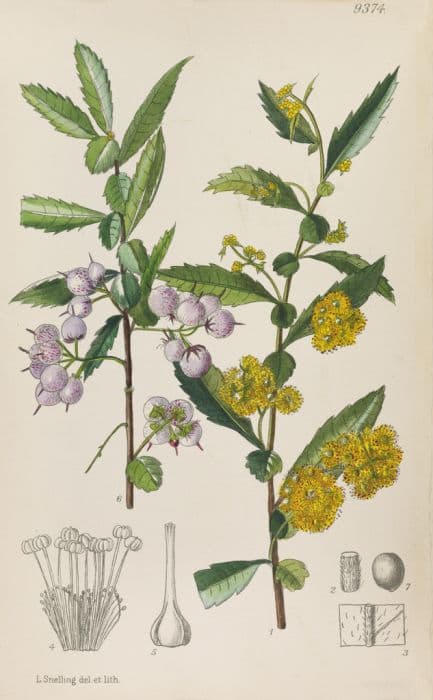Pink Pussy Willow Salix gracilistyla 'Mount Aso'

ABOUT
Salix gracilistyla 'Mount Aso' is visually striking, primarily known for its vibrant early-spring display. It is commonly referred to as the pink pussy willow due to its unique and colorful catkins. The plant produces soft, fluffy catkins that start out silvery-gray and eventually mature into a bright pink that provides a burst of color to the late winter and early spring landscape. The leaves of the pink pussy willow are slender and lance-shaped, with a glossy green surface on top and a more matte texture underneath. They create a lush, flowing canopy that moves gracefully in the breeze. Often, the foliage can also have a bluish-green tone, which contrasts elegantly with the pink catkins. The bark of the pink pussy willow is another feature of note, which is usually smooth and may range in color from gray to brown, often providing a visually appealing texture in the garden even when the plant is not in bloom. This pink pussy willow's branches are slender and can have an upright or slightly weeping habit, depending on how they are pruned and managed, which adds to the plant's ornamental value. Overall, the appearance of Salix gracilistyla 'Mount Aso' is both delicate and exuberant, making it a beloved variety for adding color and movement in the garden.
About this plant
 Names
NamesSynonyms
Pink Pussy Willow, Mount Aso Willow, Japanese Pussy Willow
Common names
Salix gracilistyla 'Mount Aso'.
 Toxicity
ToxicityTo humans
The plant commonly known as Japanese pink pussy willow is not known to be toxic to humans. Consequently, there typically aren't any symptoms associated with poisoning from this plant, as it's generally considered safe.
To pets
Similar to its effects on humans, Japanese pink pussy willow is not commonly recognized as being toxic to pets. No symptoms of poisoning or toxic consequences are generally expected if pets ingest parts of this plant.
 Characteristics
CharacteristicsLife cycle
Perennials
Foliage type
Deciduous
Color of leaves
Green
Flower color
Pink
Height
6 feet (1.8 meters)
Spread
5 feet (1.5 meters)
Plant type
Shrub
Hardiness zones
5
Native area
Japan
Benefits
 General Benefits
General Benefits- Ornamental appeal: Salix gracilistyla 'Mount Aso', commonly known as pink pussy willow, has distinctive pink and fluffy catkins that attract gardeners looking for unique ornamental plants.
- Early spring interest: It is one of the first plants to bloom in spring, providing early color and texture to landscapes after winter dormancy.
- Wildlife habitat: The catkins provide an early source of nectar and pollen for bees and other pollinators, which are important for maintaining healthy ecosystems.
- Soil erosion control: As a willow species, it is effective in stabilizing soil and preventing erosion, particularly along riverbanks and wet areas.
- Flexibility in planting: This plant can thrive in a range of soil types, including wet, clay, and poor soils, making it suitable for various landscape situations.
- Low maintenance: Once established, pink pussy willow requires minimal care, making it a good choice for gardeners seeking low-maintenance plants.
- Deciduous interest: It sheds its leaves in autumn, providing seasonal change and interest in the garden landscape.
- Can be easily propagated: Pink pussy willow can be easily propagated through cuttings, allowing gardeners to produce new plants affordably and sustainably.
 Medical Properties
Medical Properties- This plant is not used for medical purposes.
 Air-purifying Qualities
Air-purifying QualitiesThis plant is not specifically known for air purifying qualities.
 Other Uses
Other Uses- Japanese pussy willow can be used for basket weaving due to its long, flexible branches that can be woven into various shapes.
- The plant’s twigs are often used in floral arrangements and decorative displays, especially during festive seasons for their aesthetically pleasing catkins.
- Its branches may be used as natural fencing or living structures in gardens when densely planted and pruned into shape.
- Japanese pussy willow is utilized in bonsai art, providing a unique form with its soft, silvery catkins contrasting with miniature landscapes.
- Gardeners may use this plant as a means of erosion control on slopes due to its extensive root system that holds soil in place.
- The plant can serve as a habitat and food source for wildlife, particularly birds that may nest in its branches and eat the buds.
- In some cultures, the branches are used as charms or decorations during certain events, symbolizing fertility or protection.
- Dried branches with catkins are used in crafts, such as making wreaths or other decorative items for the home.
- Japanese pussy willow can be planted as a windbreak, helping to reduce the wind speed in open areas and protect smaller plants.
- The catkins are sometimes used in the production of natural dyes, providing subtle colors to fabrics and materials.
Interesting Facts
 Feng Shui
Feng ShuiThe plant_name is not used in Feng Shui practice.
 Zodiac Sign Compitability
Zodiac Sign CompitabilityThe plant_name is not used in astrology practice.
 Plant Symbolism
Plant Symbolism- Flexibility: Similar to other willow family members, the 'Mount Aso' pink pussy willow represents flexibility due to its supple branches that bend without breaking.
- Survival: The willow's ability to grow and even thrive in challenging conditions symbolizes survival and adaptation to life's hardships.
- Feminine grace: The soft, delicate catkins of the 'Mount Aso' pink pussy willow are often associated with qualities of femininity and grace.
- New Beginnings: As one of the first plants to bloom in spring, it symbolizes renewal and the start of new ventures.
- Healing: Historically, willows have been used for their medicinal properties, making them a symbol of healing and recuperation.
 Water
WaterThe Pink Pussy Willow prefers consistently moist soil, especially during the growing season in spring and summer. It should be watered deeply once a week, providing about 1 to 2 gallons per watering session, ensuring that the water reaches the roots but does not waterlog the soil. In the hotter seasons or drought conditions, check the topsoil for dryness every few days and water as needed. During the winter months, reduce watering to every other week or less, depending on the amount of rainfall and the soil moisture level.
 Light
LightPink Pussy Willows thrive best in full sun to partial shade. They should be planted in a spot where they can receive at least six hours of direct sunlight a day, though they can tolerate some shade, especially in the afternoon during the hottest part of the day. Ensure it's a location that protects the plant from intense, midday sun which can be too harsh for its leaves.
 Temperature
TemperaturePink Pussy Willows are hardy and can tolerate a range of temperatures. They can survive winter temperatures as low as -10 to -20 degrees Fahrenheit and do well in conditions up to 80 degrees Fahrenheit. The ideal growing temperatures for this willow are between 40 and 75 degrees Fahrenheit, which encourages healthy growth and flowering.
 Pruning
PruningPruning the Pink Pussy Willow is vital for maintaining its shape and promoting new growth. Prune in late winter or early spring before new growth starts, trimming back last year's growth by about a third. This timing allows for the neatest cuts and causes the least stress to the plant. Remove any dead or damaged branches whenever they are noticed to keep the plant healthy.
 Cleaning
CleaningAs needed
 Soil
SoilPink Pussy Willow thrives in well-draining soil enriched with organic matter; a mix of loam, peat, and sand is ideal. They prefer a slightly acidic to neutral pH, ranging from 6.0 to 7.0.
 Repotting
RepottingPink Pussy Willow generally doesn't require frequent repotting and will do well if repotted every 2-3 years or when it becomes root-bound.
 Humidity & Misting
Humidity & MistingPink Pussy Willow prefers moderate to high humidity levels but is adaptable and can tolerate the drier conditions typical of many temperate climates.
 Suitable locations
Suitable locationsIndoor
Bright light, cool room, keep soil moist.
Outdoor
Full sun to partial shade, shelter from strong winds.
Hardiness zone
4-8 USDA
 Life cycle
Life cycleThe life cycle of the Pink Pussy Willow (Salix gracilistyla 'Mount Aso') starts with seed germination, typically in the spring when they are spread by wind or water. The seeds quickly sprout and develop a root system to take up water and nutrients, and a shoot that grows upwards. As the young willow establishes, it enters a rapid growth phase, with both its roots and shoots elongating. This species often develops multiple stems and a bushy form, with leaves unfolding as the plant grows. In late winter to early spring, before the new leaves emerge, catkins appear which are the flowering parts and are especially notable in 'Mount Aso' for their pink color. After pollination by the wind or insects, the catkins produce tiny seeds that are again dispersed, completing the cycle.
 Propogation
PropogationPropogation time
Late Winter to Early Spring
The Japanese pussy willow, with its characteristic pink catkins, is mainly propagated through hardwood cuttings. This method is most successful when cuttings are taken in late fall to winter, when the plant is dormant. To propagate, one would select a healthy branch from the current or previous year's growth and cut a piece roughly 6 to 12 inches (15 to 30 cm) long. The cutting should have several nodes, which are the points on the branch from which new growth can sprout. The bottom end of the cutting is then dipped in rooting hormone to encourage root development and planted in a moist potting mix or directly in the ground. It's important to keep the soil consistently moist until the cutting has established a strong root system, which is generally evident when new growth appears at the top of the cutting. This simple method is effective and maintains the genetic qualities of the parent plant.









